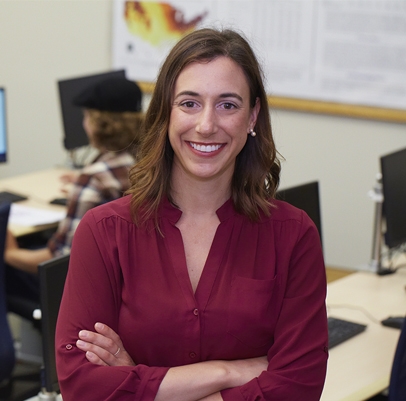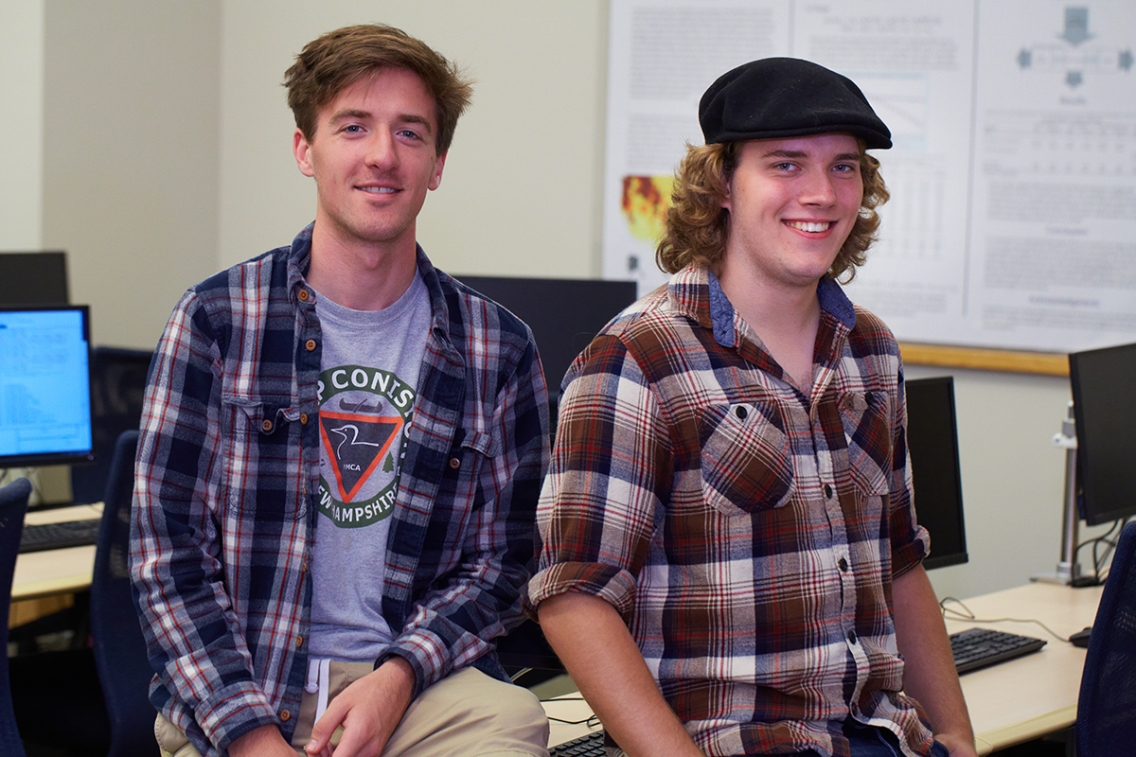Middlebury Economist Uncovers Why Employment Rates of Men with No College Experience Have Been on the Decline

MIDDLEBURY, Vt. – In 1950, a man without any college experience was as likely to be employed as his college-educated counterpart.
Not so today.
In 1950, 91 percent of men with just a high school diploma or less had a job. By 2016 that number had plummeted to 78 percent (rebounding from a low of 74 percent at the depths of the Great Recession). By contrast, for men with at least one year of college the percentage employed has more or less held steady.
Middlebury economist Erin Wolcott wants to know why.
Some economists, she explained, argue that so-called “low-skilled” men are choosing to drop out of the economy to live on welfare payments or play video games or because of opioid addictions or other health problems. Some argue that the decline in manufacturing jobs is to blame. Some argue that increased difficulties in the job search itself—whether from lack of access to technology or geographic mismatch—have disadvantaged this same group.
“The economist’s role is to help policy makers understand what’s going on so they can design optimal policy to benefit society,” said Wolcott. “If noncollege men aren’t working because there are no jobs, we could implement training programs or stimulate certain sectors of the economy. If it’s because of health or video games or whatever, there are other policy levers we can pull.”
Wolcott is running what she calls “a horse race” to see which hypothesis wins on the merits that count most—the data.

Ben Lahey ’21 and Lachlan Pinney ’21 worked as research assistants with Professor Erin Wolcott.
To run her horse race, Wolcott has built a mathematical model that she can vary to test each explanation against the others.
“The same way that architects build scale models out of balsa wood and foamcore, economists build models out of math,” explained Wolcott. “In both cases, the model is a simplification of reality that helps the researcher understand big ideas.”
The code behind Wolcott’s model is thousands of lines long and so complex it takes over eight hours to crunch the numbers.
“Erin works with unbelievable amounts of data,” said colleague Peter Matthews, Charles A. Dana Professor of Economics, “millions and millions of observations.” Big data, he said, allows researchers both to better discern patterns and to better test a given explanation of those patterns.
“There’s a lot of excitement these days around big data,” said Matthews. “One of the ways in which Erin’s work is unusual is that most people who work with this kind of data tend to be, ironically, interested in small micro questions. But Erin’s a big-picture macro person.”
Wolcott’s research is also important, continued Matthews, because she focuses on employment rather than unemployment. Many countries track the employment rate as a long-run indicator of economic health; less so the United States.
“When we pick up the news, we hear about the unemployment rate, we hear about the stock market, we hear about inflation, we hear about all those things. We almost never hear about the employment rate: What fraction of eligible Americans are actually working? Erin’s shining a spotlight on a little-appreciated pattern in the U.S. labor market. She’s bringing attention to the importance of the employment rate as a macro-indicator.”
Wolcott’s research is also important in its conclusions, said Matthews: “She takes a surprising and concerning fact about the world, evaluates a host of competing explanations, and finds that some of the most popular explanations aren’t the right ones.”
The winning horse when Wolcott runs her model? Job loss. The data points that make this horse the winner? Declining wages.
In the late 1970s, real hourly wages for noncollege men were around $25 an hour. Today they’re $21, said Wolcott. If employers needed to lure these workers off the couch, wages would have gone up. Instead, they’ve gone down by 16 percent, as these same jobs have gone to automation or overseas.
By contrast, real hourly wages for men with at least one year of college have risen by 13 percent, from $32 to $36.
Wolcott’s interest in the economic big picture—labor economics, globalization, international finance—was cemented by a stint at the Fed, just out of college.
From 2009 to 2011, she worked as a researcher with the Federal Reserve Board of Governors, in Washington, D.C., as it wrestled with how to best respond to the country’s worst financial crisis since the 1930s.
“It was an extremely exciting and scary time and that experience shaped my desire to be a macroeconomist,” said Wolcott. “Things weren’t looking so good and the Fed was trying to fix it. And so I thought, ‘Yeah. I want to be part of that policy discussion on how we can improve economic conditions for people who are struggling.’”
Wolcott discovered her love of economics as an undergraduate, almost by accident.
“I didn’t know what I was going to major in, so I was just testing everything out, and I took my first economics class and fell in love with it. It’s a framework, a tool set, to think about the modern world and understand how it works.”
Which aspect most set her on fire?
“The math,” said Wolcott, who comes from a family of high school math teachers.
“Writing down these individual and aggregate interactions in math really got me hooked. The equations we use to represent how people make decisions aren’t perfect by any means, but they’re a way to simplify this really complex, messy world, such that we can understand what’s going on. I had never seen anything like that until I took my first economics class.”
Like Wolcott, Middlebury sophomore Lachlan Pinney was taking classes and exploring interests when he discovered economics.
“This was second semester. Macroeconomics. 8 a.m.”
Despite the early hour and his belief that economics wasn’t going to be his thing, something clicked.
“Having a passionate teacher goes a very long way,” said Pinney. The course changed how he saw himself and factored heavily into his decision to major in international politics and economics.
Fellow sophomore Feb Benjamin Lahey also changed direction after taking Wolcott’s macroeconomics class concurrently with a class in game theory.
“Seeing even the beginnings of how researchers analyze and model the decisions that people make, not just on an individual level but on a country level, was just so interesting. It kind of pushed me over from humanities to a lot of numbers. I had been totally set on humanities, but after those two classes, I came out econ and math instead.”
This summer, Pinney and Lahey worked as Wolcott’s research assistants.
“I love getting to involve my students in this research that I’m passionate about,” said Wolcott. “Being a research assistant at the Fed was such a formative experience, so now to be on the other side and get to share this research project with students who are figuring out what they want to do is really rewarding.”
For Pinney and Lahey, it’s an introduction to the rigors of professional economics research.
On their first day, Wolcott assigned them a bar graph on differential market tightness—a graph she’d already created—and asked them to check the code for any errors and see if they could improve the data, which had to be aggregated and weighted from a variety of sources.
“We’re like, it’s a bar graph, we’ve been doing those since sixth grade, it’s going to be very, very easy. This will be a day of work, if that,” said Lahey. “But then it’s just like the getting to the actual numbers that create the bar graph is lines and lines and lines of code. There’s so many different iterations that we’ve played with—Do you include this group of people? Do you not? Do you group these people together? How do you classify this thing? How do you do this?—that it’s already been two weeks and we still don’t have a final version of this three-color bar graph.”
Wolcott’s examination of employment is based, necessarily, on publicly available data. But that data wasn’t collected to answer her current research questions. So if what she needs, finally, is to compare apples to apples, the data she’s starting from is like comparing apples to oranges to pineapples to lychee fruit.
“Publicly available data is messy. It’s very messy,” said Wolcott. “We have to transform it so it’s useful.”
Bringing Lahey and Pinney into the research, said Wolcott, also brings a fresh perspective on what’s been a solo endeavor.
“It’s been wonderful to have other people to chat with and brainstorm. That’s been a new and really fantastic thing.”
Matthews describes Wolcott as a rare find: an economist who’s “pushing the boundaries of knowledge” with groundbreaking research and “wants to share that with 18- and 19- and 20-year-olds.”
Said Pinney: “There was an immediate sense of trust in us. That was really key. From the get-go, Professor Wolcott gave us confidence that we were able to do these complex tasks, and I appreciate that very much. That’s one of the things that I’ve really appreciated above all.”
By Gaen Murphree; Photos by Todd Balfour

